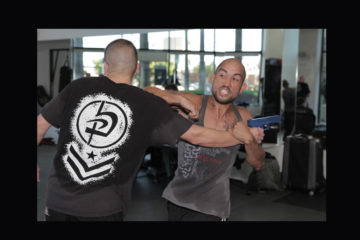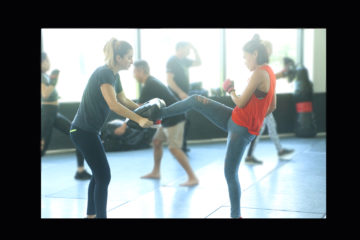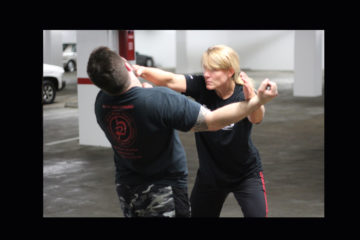The Krav Maga Fighting style is a unique skill system built for survival. It was developed for diffusing real-world situations and was put to the test in hostile police work, military battles, and street fights. Throughout his life, founder Imi Lichtenfeld was able to perfect his self-defense training and adapt it for use not only by law enforcement and military but also for the average civilian.
Here are just some of the factors that set Krav Maga apart from other fighting and self-defense systems.
1. A Self-Defense System, Not a Martial Art
Martial arts can be defined as a codified system of movements meant for combat or competition. The Krav Maga fighting style, on the other hand, is a practical self-defense system. If you have ever attended a martial arts competition, you may have noticed the fights seem almost choreographed. This is due to the fact that most martial arts students learn specific fighting moves and routines according to rigid traditions. Many of these moves call for a specific response from the student. Classes are taught to perform rhythmic, repetitive drills, rather than respond to sporadic, real-life events. In addition, martial arts typically have a spiritual element.
Krav Maga uses simpler movements and techniques to prepare students for real emergencies. It’s not about centering you or honoring cultural traditions; it’s about saving your life.
2. Training for Real-World Situations, Not Organized Competitions
Krav Maga trains you to think on your feet, counter attackers, and then strike back. Students learn to improvise in order to gain the upper hand against an adversary. The Krav Maga fighting style is meant for situations that can happen to anyone, on any given day, with muggers, rapists, kidnappers, or anyone who would hurt you or your loved ones. Krav Maga is not designed nor meant solely to be practiced in a competition; it is for real-world instances in which your life is at stake.
This is why Krav Maga was also developed as a defensive tactics system for law enforcement officers and members of the military who face hostile adversaries in combat situations on a regular basis.
3. There Are No Rules in a Self-Defense Situation
Hopefully, you have never experienced a situation in which you felt your life may have been in danger because of another who wanted to cause you harm, but many of us have had an experience like this. Ask a few friends and you will hear stories about being followed down a dark street late at night, a belligerent drunk who wanted to start a fight with the next Joe who looked at him wrong, a catcaller who wouldn’t take no for an answer, or a stranger tailing a mother and baby around the grocery store. One look at the daily local news will confirm that these occurrences can happen.
Unlike a martial arts competition where weapons may be banned and some moves may be considered dishonorable, real-life instances can involve weapons. Attackers will throw cheap and dirty moves at you to win a fight by any means necessary.
This is where, in the race to live, the Krav Maga fighting style teaches you to be a survivor, no matter what it takes, and bring your assailant down. Whether it be with a swift kick to the groin or a crowbar to the neck, the goal of the Krav Maga self-defense system is to save your life.
4. Simplicity for the Sake of Simplicity
Krav Maga is great for beginners because it’s practical right from day one. The simplicity of this system means that anyone can pick up the fundamentals in a short amount of time, even with no prior experience. The basics of your self-defense training will teach you to use your natural weapons — like your fists, knees, elbows, and feet — to defend against strikes, weapons, and chokes. Instructors use realistic, varied training drills to drive the techniques home, so when the occasion arises, your gut reaction will be to react as you have learned and practiced. Overly complex moves are difficult to recall in the heat of the moment, so the Krav Maga fighting style teaches skills that are based on instinctive movements and easy to remember.
Advanced Krav Maga fighting classes involve sparring drills with partners taught by experienced instructors. These classes help individuals practice and improve their techniques and continue to grow as fighters. Krav Maga fitness classes are also offered for those who want to burn fat or tone muscle as they train.
The Krav Maga fighting style is so simple that it has even been adapted for children to learn to tackle everyday situations that commonly happen in school, on the playground, or on the way home. Krav Maga for kids also teaches them to stay fit, handle surprise situations, and have confidence in themselves.
5. Learn to Be Truly Aware of Your Situation
There are several factors that will determine how best to confront an adverse situation. For example:
- What time of day is it?
- What are you wearing?
- What items are you carrying?
- Are other people nearby?
- Are you disabled?
- Are you sick and therefore not as physically capable as you would normally be?
The Krav Maga fighting style is unique because it teaches you to identify elements of a situation that would put you at a disadvantage and how to counteract them. One of the most important aspects of diffusing a negative situation is learning how to react appropriately and having the reflexes to do so. Through your self-defense training, you will find that your problem-solving skills and reaction time will improve with practice.
Visit www.kravmaga.com to learn more about the Krav Maga Worldwide fighting style and sign up for these one-of-a-kind self-defense classes.






